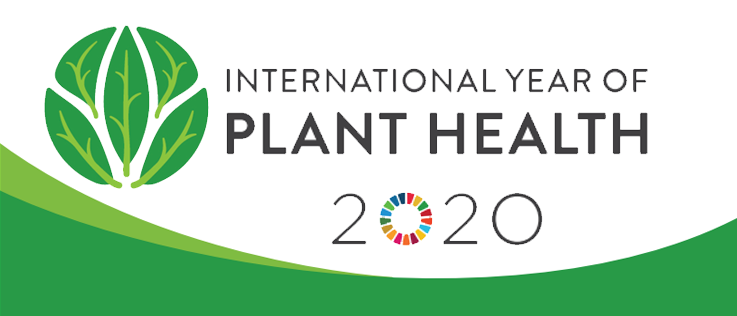
The United Nations has designated 2020 as the International Year of Plant Health. I welcome the possibility of heightened awareness – although it could result in promises that are more optimistic than facts warrant.
APHIS and probably other national and international phytosanitary bodies have planned events to draw attention to the importance protecting of plant health. For example, the APHIS website lists numerous meetings, some of which are special events, e.g., Safeguarding 2020: North American Safeguarding and Safe Trade Conference in Washington, DC, in August. Another event is a continuation of the Entomological Society of America’s Grand Challenges event, “Pre-border Prevention: A New Conversation on Invasive Pest Pathways Through Trade” – which will take place in Orlando in November.
I repeat that we should support the international phytosanitary community’s efforts to raise political leaders’ awareness of the importance of preventing phytosanitary disasters.
However, at the same time, the international system that, for more than two decades, has governed trade, with all its associated phytosanitary risks and regulations, is falling apart.
The World Trade Organization – which is the basis for international trade rules – is under unprecedented threat. United States has blocked nomination of individuals to the World Trade Organization’s Dispute Panel. As of December 10, 2019 the Panel no longer has a quorum. As a result, experts expect countries to revert to the pre-WTO practice of bullying trade “partners” with whom they have a quarrel. They will probably erect tariffs and other barriers in order to force other parties to concede. Phytosanitary requirements might again be governed by individual countries’ bilateral agreements, leading to confusion and perhaps a “race to the bottom” in the name of facilitating trade.
Collapse of the WTO rules alarms me – despite my having criticized WTO restrictions on strong national phytosanitary measures over the past 25 years. (The restrictions were imposed by the WTO’s Agreement on the Application of Sanitary and Phytosanitary Measures – the SPS Agreement). For more details, see Fading Forests II. All-out country vs. country trade battles seldom put a priority on preventing the movement of pests. At least under WTO SPS, there has been a process for addressing pest problems.
Most phytosanitary issues – including development of international standards – are addressed under the International Plant Protection Convention. The IPPC is a separate organization from the WTO, so it might continue to function with fewer disruptions. Still, much of its clout comes from its recognition by the WTO SPS as the standard-setting body for plant health matters.

Of course, there are benefits associated with individual countries’ acting independently. Might the current collapse of trade rules allow the U.S. to adopt more stringent regulations governing introduction pathways of concern to us — for example, wood packaging? Can we hope that an administration focused on “America First” take aggressive phytosanitary actions to protect our agriculture and environment?

Unfortunately, I see no indications that the U.S. Department of Agriculture – much less other agencies – might seize this opportunity.
The United Kingdom has an even greater opportunity to act independently, since it is “Brexiting” the European Union in January 2020. In theory, the UK is now free to adopt its own phytosanitary measures. A House of Lords committee held extensive hearings to explore options in 2018.

While eminent plant pathologist Clive Brasier and others urged the UK to adopt more stringent rules based on a precautionary approach – for example, by banning imports of semi-mature trees with large root balls – the committee noted that the British government has often said that it wants to maintain “seamless” trade with the EU. It therefore seems unlikely that the UK will seize this opportunity to erect more effective phytosanitary barriers to prevent pest introductions to the islands.
Meantime, the European Union is making some mildly encouraging changes. Europe (including the UK) has the highest number of introduced tree-killing non-native pathogens of any continent – five times more than North America (Ghelardini 2017). Europe has a much more leaky phytosanitary system for plant imports than does the United States. See also Jung et al. (2015), Roy et al. (2014), the Montesclaros Declaration.

In response to growing awareness of the plant pest threat, EU officials have gone through a multi-year process to strengthen phytosanitary rules governing movement of plants for planting (living plants, such as nursery stock). The process was described in Klapwijk et al. (2016) and discussed in my blog in October 2016. The new rules took effect in December 2019. The new European Commission regulation simplifies and harmonizes the “plant passport” system, under which plants are moved among EU member states. Plant imports that pose the greatest risk – called “priority pests” – are subject to enhanced measures concerning surveys, action plans for their eradication, contingency plans and simulation exercises. Plants for planting and plant products being imported into the EU will be subject to varying levels of restrictions, including prohibition of importation of those posing the highest risk. Less risky plants must be accompanied by a phytosanitary certificate issued by the phytosanitary agency of the exporting country (House of Lords report). The new system no longer depends on a list of harmful plant pests, but instead “sets out the conceptual nature of quarantine pests” and empowers the Commission to adopt measures to control certain pests (Klapwijk et al. (2016)).
Three years ago, Klapwijk et al. (2016) praised the new approach as a significant step forward. However, they note that the new rules still don’t provide for precautionary assessments of high-risk commodities. Nor do they actually restrict import of the highest-risk commodities, such as imports of large plants or plants in soil (my emphasis). Such restrictions still must be enacted separately. Organisms whose pest status is unknown will continue to be allowed into the EU. (See discussions of the impact of failing to curtail imports of “unknown unknowns” by Brasier (2008) and in Fading Forests II.
(While the U.S. also does not address organisms with unknown pest potential, it is much more stringent regarding sizes of plants, presence of soil or other growing media, and other issues. Furthermore, it has the NAPPRA process, which facilitates a more rapid response to emerging pest threats.)
Posted by Faith Campbell
We welcome comments that supplement or correct factual information, suggest new approaches, or promote thoughtful consideration. We post comments that disagree with us — but not those we judge to be not civil or inflammatory.
SOURCES
Brasier CM. 2008. The biosecurity threat to the UK and global environment from international trade in plants. Plant Pathology 57: 792–808.
Ghelardini, L., Luchi, N., Pecori, F., Pepori, A.L., Danti, R., Della Rocca, G., Capretti, P., Tsopelas, P. , Santini, A. 2017. Ecology of invasive forest pathogens. Biological Invasions. June 2017
Jung, T. et al. 2015 “Widespread Phytophthora infestations in European nurseries put forest, semi-natural and horticultural ecosystems at high risk of Phytophthora disease” Forest Pathology. November 2015;
Klapwijk, M., Hopkins, A.J.M., Eriksson, L. Pettersson, M., Schroeder, M., Lindelo¨w, A., Ro¨nnberg, J. Keskitalo, E.C.H., Kenis, M. 2016. Reducing the risk of invasive forest pests and pathogens: Combining legislation, targeted management and public awareness. Ambio 2016, 45(Suppl. 2):S223–S234 DOI 10.1007/s13280-015-0748-3
Roy, B.A., Alexander, H.M., Davidson, J., Campbell, F.T., Burdon, J.J., Sniezko, R., and Brasier, C. 2014. Increasing forest loss worldwide from invasive pests requires new trade regulations. Frontiers in Ecology https://cpb-us-e1.wpmucdn.com/blogs.uoregon.edu/dist/1/11561/files/2018/07/Roy-et-al-2014-Frontiers-12p4898.pdf